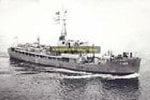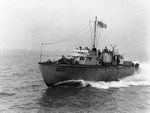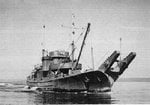- Thread starter
- #1,861
Njaco
The Pop-Tart Whisperer
June 26 Thursday
ASIA: IJN aircraft carrier "Junyo" launched after conversion from passenger liner.
EASTERN FRONT: Unternehmen Barbarossa: Zhukov returns from Southwestern Front to Moscow and meets with Stalin, Timoshenko, and Vatutin about critical situation of the Western Front. Konev takes command of Soviet 19th Army. Meretskov recalled from Leningrad, arrested and tortured, but subsequently released and rehabilitated after implicating other Soviet generals in anti-Stalin plot.
Armeegruppe Nord: German forces of Armeegruppe Nord capture Dünaburg in Latvia and 4.Panzergruppe forces begin working to take bridgeheads over the Dvina River. Tanks of von Manstein's 4.Panzergruppe capture the Dvina River bridges at Daugavipils intact German. 18.Armee was engaged in heavy fighting around Liepaja while 4.Panzergruppe shattered Soviet 3rd and 11th Mechanized Corps. German 56.Panzerkorps reached Daugava River (Western Dvina) as 8.Panzerdivision and 3.Motorisierte Abteilung established bridgehead near Daugavpils, Latvia. German forces captured Daugavpils. Hitler orders these forces to stop, consolidate, gather supplies and wait for the infantry forces, far to the rear, to catch up. Luftwaffe bombers attack Leningrad.
Siege of Hango: The Russian garrison at Hango holds out in the naval base, west of Helsinki, until evacuated, in December 1941. Finnish ground troops quickly isolated Hanko and its 25,300-man Soviet garrison. Though Mannerheim initially declared that liberating Hanko would be a primary goal of the war, Finnish troops in the area did not receive authorization to attack the base. Instead, as the Finns had built the Harparskog line on the border of the leased area during the Interim Peace, they moved to occupy these positions. The front remained mostly static, with action consisting mainly of artillery strikes and some limited probing or patrol activities on both sides. Small scale naval and amphibious actions took place in the surrounding archipelago. Finnish forces surrounding the base initially consisted of the 17th Division, the 4th Coastal Brigade, and supporting units.
Armeegruppe Mitte: German Panzer units closed the Bialystok pocket in Poland as German 3.Panzergruppe reaches the edge of Minsk. The 7.Panzerdivision (Rommel's old unit from France) driving north of Minsk, cuts the Minsk-Moscow highway, the main supply route for the Soviet West Front. Soviet Western Front becomes isolated by German Armeegruppe Mitte. General Boldin, deputy commanding officer of Soviet Western Front, was trapped in encirclement west of Minsk. German 2.Panzergruppe continued its push toward Bobruisk. Guderian's 2.Panzergruppe is driving hard to complete the encirclement of the Soviet forces around Minsk.
In Belarus Soviet NKVD mass-executed prisoners from Minsk in the nearby Tsagelnya forest. The wooden statue Mourning Ange, by sculptor Gennady Matusevich, was later erected at the location. Commemorative events are held every year in June.
Armeegruppe Sud: The Soviets launch fresh and very strong counterattacks against the German spearheads. These attacks fall particularly hard on the 16.Panzerdivision in the area around Ostrov. Soviet 9th, 15th, and 19th Mechanized Corps counterattacked German 6.Armee and 1.Panzergruppe. Further to the north, 11.Panzerdivision is blocked in it's advance at Dubno. The advance of this army group is temporarily stopped. By the evening of June 26, 1941, at Brest Fortress most of the northern Kobrin fortification, except the East Fort, was captured. Small Soviet forces tried to break out from the siege but were unsuccessful and sustained heavy casualties.
In the northeastern city of Iasi, Romania, up to 12,000 people are believed to have died as Romanian and German soldiers swept from house to house to killing Jews. Those who did not die were systematically beaten, put in cattle wagons in stifling heat and taken to a small town, where what happened to them would be concealed. Of the 120 people on the train, just 24 survived. In 2010 a mass grave was found containing the bodies of an estimated 100 Jews killed by Romanian troops in a forest near the town of Popricani, about 350 km northeast of Bucharest. It contained the bodies of men, women and children who were shot in 1941.
Aircraft of the German Luftwaffe began to bomb Leningrad, Russia. Hptm. Lothar Keller of II./JG 3 is killed in an accident flying a Fiesler Storch. He had four Russian victories to bring his total to twenty victories overall. His place as Gruppenkommandeur is taken by Hptm. Gordon Gollob. Near Daugavpils Lt. Max-Hellmuth Ostermann of 7./JG 54 destroys a Soviet DB-3. JG 51's Kommodore, Obstlt. Mölders destroys a Russian Pe-2 and an I-16 to reach seventy-seven kills. Joachim Brendel of JG 51 destroys a Soviet DB-3 for his first victory in the air.
In the Soviet capital of Moscow, Joseph Stalin visited the General Staff headquarters twice, voicing frustration at the heavy losses that the Red Army was suffering against the invading German forces.
Bombing of Kassa: Two aircraft bombed the Hungarian border town of Kassa, killing 20 and injuring 41. Hungary blamed USSR, but the raid was probably fabricated by Luftwaffe. This attack became the pretext for Hungary to declare war on the Soviet Union the following day.
Soviet task force led by cruiser "Voroshilov" bombards Constanza. Soviet flotilla leader "Moskva" was sunk by a mine during Constanza operation. Soviet aircraft suffered heavy losses during the attack on Constanza, trying to support the naval operation.
GERMANY: Adolf Hitler officially named Hermann Göring his successor.
RAF Bomber Command sends 51 aircraft to attack Cologne, 44 aircraft to attack Dusseldorf and 41 aircraft to attack Kiel overnight.
MEDITERRANEAN: Operation Railway I: Twenty two aircraft were transferred to "Ark Royal" which sailed from Gibraltar escorted by "Renown", "Hermione" and "Faulknor", "Forester", "Fury", "Lance" and "Legion" to reinforce Malta.
MIDDLE EAST: Tomahawk fighters of No. 3 Squadron RAAF destroyed 5 French D.520 fighters and damaged a further six on the ground at Homs Airfield in Syria.
NORTH AMERICA: The mixed Marine-Army I Corps (Provisional), which was attached to the US Navy Atlantic Fleet, was redesignated Task Force 18 of the Atlantic Fleet.
NORTH AFRICA: Allied aircraft attack airfields at Gazala.
NORTHERN EUROPE: Finland issued declaration of war against the Soviet Union.
In the Baltic Sea, Soviet warships conducted minelaying operations while Kriegsmarine S-boats conducted minelaying operations. After running into each other while both groups were minelaying, Kriegsmarine S-boats engaged the Soviet warships. Estonian vessel "Lidaza" was sunk by Kriegsmarine S-boats.
In Norway an adviser to collaborationist leader Vidkun Quisling suggested in a letter, four days after Hitler invaded the Soviet Union, that northern Russia would be better used by Germanic peoples because Slavic peoples "don't know how to make use of the land." The document was not made public until 2010.
WESTERN FRONT: Spain officially began to organize a unit of volunteers to fight in Russia on the side of the Axis.
RAF Fighter Command conducts major sweep along French coast. RAF 11 Group Circus 24 was an attack on the power station at Comines. 23 Blenheim IVs of 2 Group were escorted by fighters from 19 squadrons. Bombers abandoned mission because of thick haze.
.

ASIA: IJN aircraft carrier "Junyo" launched after conversion from passenger liner.
EASTERN FRONT: Unternehmen Barbarossa: Zhukov returns from Southwestern Front to Moscow and meets with Stalin, Timoshenko, and Vatutin about critical situation of the Western Front. Konev takes command of Soviet 19th Army. Meretskov recalled from Leningrad, arrested and tortured, but subsequently released and rehabilitated after implicating other Soviet generals in anti-Stalin plot.
Armeegruppe Nord: German forces of Armeegruppe Nord capture Dünaburg in Latvia and 4.Panzergruppe forces begin working to take bridgeheads over the Dvina River. Tanks of von Manstein's 4.Panzergruppe capture the Dvina River bridges at Daugavipils intact German. 18.Armee was engaged in heavy fighting around Liepaja while 4.Panzergruppe shattered Soviet 3rd and 11th Mechanized Corps. German 56.Panzerkorps reached Daugava River (Western Dvina) as 8.Panzerdivision and 3.Motorisierte Abteilung established bridgehead near Daugavpils, Latvia. German forces captured Daugavpils. Hitler orders these forces to stop, consolidate, gather supplies and wait for the infantry forces, far to the rear, to catch up. Luftwaffe bombers attack Leningrad.
Siege of Hango: The Russian garrison at Hango holds out in the naval base, west of Helsinki, until evacuated, in December 1941. Finnish ground troops quickly isolated Hanko and its 25,300-man Soviet garrison. Though Mannerheim initially declared that liberating Hanko would be a primary goal of the war, Finnish troops in the area did not receive authorization to attack the base. Instead, as the Finns had built the Harparskog line on the border of the leased area during the Interim Peace, they moved to occupy these positions. The front remained mostly static, with action consisting mainly of artillery strikes and some limited probing or patrol activities on both sides. Small scale naval and amphibious actions took place in the surrounding archipelago. Finnish forces surrounding the base initially consisted of the 17th Division, the 4th Coastal Brigade, and supporting units.
Armeegruppe Mitte: German Panzer units closed the Bialystok pocket in Poland as German 3.Panzergruppe reaches the edge of Minsk. The 7.Panzerdivision (Rommel's old unit from France) driving north of Minsk, cuts the Minsk-Moscow highway, the main supply route for the Soviet West Front. Soviet Western Front becomes isolated by German Armeegruppe Mitte. General Boldin, deputy commanding officer of Soviet Western Front, was trapped in encirclement west of Minsk. German 2.Panzergruppe continued its push toward Bobruisk. Guderian's 2.Panzergruppe is driving hard to complete the encirclement of the Soviet forces around Minsk.
In Belarus Soviet NKVD mass-executed prisoners from Minsk in the nearby Tsagelnya forest. The wooden statue Mourning Ange, by sculptor Gennady Matusevich, was later erected at the location. Commemorative events are held every year in June.
Armeegruppe Sud: The Soviets launch fresh and very strong counterattacks against the German spearheads. These attacks fall particularly hard on the 16.Panzerdivision in the area around Ostrov. Soviet 9th, 15th, and 19th Mechanized Corps counterattacked German 6.Armee and 1.Panzergruppe. Further to the north, 11.Panzerdivision is blocked in it's advance at Dubno. The advance of this army group is temporarily stopped. By the evening of June 26, 1941, at Brest Fortress most of the northern Kobrin fortification, except the East Fort, was captured. Small Soviet forces tried to break out from the siege but were unsuccessful and sustained heavy casualties.
In the northeastern city of Iasi, Romania, up to 12,000 people are believed to have died as Romanian and German soldiers swept from house to house to killing Jews. Those who did not die were systematically beaten, put in cattle wagons in stifling heat and taken to a small town, where what happened to them would be concealed. Of the 120 people on the train, just 24 survived. In 2010 a mass grave was found containing the bodies of an estimated 100 Jews killed by Romanian troops in a forest near the town of Popricani, about 350 km northeast of Bucharest. It contained the bodies of men, women and children who were shot in 1941.
Aircraft of the German Luftwaffe began to bomb Leningrad, Russia. Hptm. Lothar Keller of II./JG 3 is killed in an accident flying a Fiesler Storch. He had four Russian victories to bring his total to twenty victories overall. His place as Gruppenkommandeur is taken by Hptm. Gordon Gollob. Near Daugavpils Lt. Max-Hellmuth Ostermann of 7./JG 54 destroys a Soviet DB-3. JG 51's Kommodore, Obstlt. Mölders destroys a Russian Pe-2 and an I-16 to reach seventy-seven kills. Joachim Brendel of JG 51 destroys a Soviet DB-3 for his first victory in the air.
In the Soviet capital of Moscow, Joseph Stalin visited the General Staff headquarters twice, voicing frustration at the heavy losses that the Red Army was suffering against the invading German forces.
Bombing of Kassa: Two aircraft bombed the Hungarian border town of Kassa, killing 20 and injuring 41. Hungary blamed USSR, but the raid was probably fabricated by Luftwaffe. This attack became the pretext for Hungary to declare war on the Soviet Union the following day.
Soviet task force led by cruiser "Voroshilov" bombards Constanza. Soviet flotilla leader "Moskva" was sunk by a mine during Constanza operation. Soviet aircraft suffered heavy losses during the attack on Constanza, trying to support the naval operation.
GERMANY: Adolf Hitler officially named Hermann Göring his successor.
RAF Bomber Command sends 51 aircraft to attack Cologne, 44 aircraft to attack Dusseldorf and 41 aircraft to attack Kiel overnight.
MEDITERRANEAN: Operation Railway I: Twenty two aircraft were transferred to "Ark Royal" which sailed from Gibraltar escorted by "Renown", "Hermione" and "Faulknor", "Forester", "Fury", "Lance" and "Legion" to reinforce Malta.
MIDDLE EAST: Tomahawk fighters of No. 3 Squadron RAAF destroyed 5 French D.520 fighters and damaged a further six on the ground at Homs Airfield in Syria.
NORTH AMERICA: The mixed Marine-Army I Corps (Provisional), which was attached to the US Navy Atlantic Fleet, was redesignated Task Force 18 of the Atlantic Fleet.
NORTH AFRICA: Allied aircraft attack airfields at Gazala.
NORTHERN EUROPE: Finland issued declaration of war against the Soviet Union.
In the Baltic Sea, Soviet warships conducted minelaying operations while Kriegsmarine S-boats conducted minelaying operations. After running into each other while both groups were minelaying, Kriegsmarine S-boats engaged the Soviet warships. Estonian vessel "Lidaza" was sunk by Kriegsmarine S-boats.
In Norway an adviser to collaborationist leader Vidkun Quisling suggested in a letter, four days after Hitler invaded the Soviet Union, that northern Russia would be better used by Germanic peoples because Slavic peoples "don't know how to make use of the land." The document was not made public until 2010.
WESTERN FRONT: Spain officially began to organize a unit of volunteers to fight in Russia on the side of the Axis.
RAF Fighter Command conducts major sweep along French coast. RAF 11 Group Circus 24 was an attack on the power station at Comines. 23 Blenheim IVs of 2 Group were escorted by fighters from 19 squadrons. Bombers abandoned mission because of thick haze.
.



